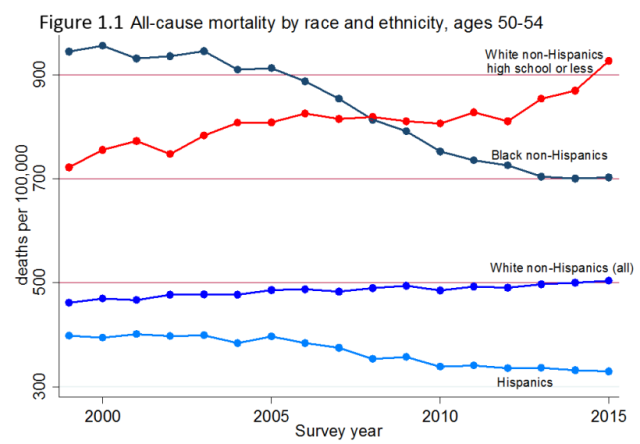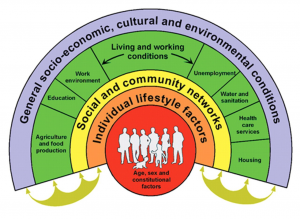
In September 2015, researchers announced that death rates have been rising dramatically since 1999 among middle-aged white Americans with a high school degree or less. This dramatic assertion contradicted decades of increasing longevity among all Americans.
A Health Affairs study found this to be especially true for white, female high school drop-outs whose life expectancy “has fallen so much over the past 18 years that these women are now expected to die five years younger than their mothers did.”
Researchers called this occurrence Deaths of Despair. Why? The deaths were mostly caused by suicide, drugs, and alcohol, not the usual things that kill Americans.
What was causing so many white, middle age Americans (45 to 54) to resort to such extreme behaviours leading to their premature deaths?
The reasons were unclear at the time. But in 2017, the same researchers followed up with a clearer explanation for why they thought these deaths were happening. The reasons have to do with what social epidemiologists call Social Determinants of Health (SDoH).
The Social Determinants of Health
Most of us are familiar with the idea of disease as a biological process. We recognize that there are genetic, dietary, and environmental elements that make us healthy or ill. But there is more to the story of what makes us healthy as individuals, as communities, and as a nation.
How often have you considered the role social conditions play as a primary source of our well-being or our state of disease?
Social scientists have steadily, over decades, documented how adverse social conditions can be directly deleterious to health outcomes. These factors are called the social determinants of health (SDoH).
According to the Centers for Disease Control and Prevention (CDC), the social determinants or causes consist of the “conditions in the places where people learn, work, and play” and they “affect a wide range of health risks and conditions.” SDoHs are the causes behind the causes. In other words, the conditions under which we live heavily influence the levels of health or the depths of illness we achieve.

The CDC further defines our health as “determined in part by access to social and economic opportunities; the resources and supports available in our homes, neighborhoods, and communities; the quality of our schooling; the safety of our workplaces; the cleanliness of our water, food, and air; and the nature of our social interactions and relationships.”
This manner of thinking owes a great debt to Thomas McKeown, a British physician who studied death records from the 19th century to the 1960s for England and Wales.
Paula Braveman, MD, indicates that McKeown discovered that mortality rates fell “steadily decades before the availability of modern medical-care such as antibiotics and intensive care units.” McKeown attributed the increase in life expectancy to “improved living conditions, including nutrition, sanitation and clean water.”
Decades of research in this vein has led Tom Boyce, Chief of University of California San Fransisco’s Division of Developmental Medicine, to confidently assert: “Socioeconomic status is the most powerful predictor of disease, disorder, injury and mortality we have.” For example, poor adults who have limited income, poor education, and job status live nearly eight years less than those whose income is well over the poverty level.
It’s been well established by social epidemiologists that health disparities are pronounced in communities that suffer poor housing, low income, dangerous neighborhoods, and substandard education.
So What’s Happening to Non-Hispanic White People in America?
Current research is finding very disturbing trends.
Case and Deaton, authors of the original research cited above, who discovered the Deaths of Despair phenomenon, published an update in March 2017 clarifying what seems to be happening nationwide.
Here’s what they have found:
- Mid-life mortality rates for all educated classes continues to fall nationwide.
- Middle-aged non-Hispanic whites with a high school diploma or less have experienced increasing mid-life mortality since the late 1990s.
- These whites now have a mortality rate 30% higher than blacks in 2015.
- Originally centered in the southwest in 2000, Deaths of Despair is now nation-wide, including Appalachia, Florida, and the west coast.
According to Prof. Shannon M. Monnat, “Over the past decade, nearly 400,000 people in the U.S. died from accidental drug overdoses and drug-induced diseases. Nearly 400,000 more committed suicide, and over 250,000 died from alcohol-induced diseases like cirrhosis of the liver.”
Most of these increases occurred among white non-Hispanics.
Why Is This Happening?
What makes non-Hispanic white Americans with high school diplomas or less resort to drugs, alcohol, and suicide?
Case and Deaton, in their 2017 article, document an array of social determinants that may explain the unfortunate predicament of a growing segment of the American population. The Brookings Institute’s summary of the research indicates that Deaths of Despair are accompanied “by measurable deterioration in economic and social well-being, which has become more pronounced for each successive birth cohort. Marriage rates and labor force participation rates fall . . . while reports of physical pain, and poor health and mental health rise.”
Case and Deaton have accumulated compelling evidence of the “pain, distress, and social dysfunction in the lives of working class whites that took hold as the blue-collar economic heyday of the early 1970s ended, and continued through the 2008 financial crisis and the subsequent slow recovery.”
With the ever-looming twin spectres of globalization and technological change, white Americans were faced with dwindling resources and shrinking opportunities. Unions faltered, mining spiralled downward, pensions disappeared, and high paying working-class jobs dwindled. Social institutions faded. Church attendance decreased, marriage became less common, while men were less likely to find good jobs or even be in the labour market at all.
These trends continue to deepen and spread. Outcomes for non-Hispanic white Americans are expected to worsen.
What Is to Be Done?
If social epidemiologists are correct, illness within a population is shaped, in part, by social dysfunctions or political imbalances such as poor educational opportunities, unemployment or underemployment, lack of access to health care, political dis-empowerment, and a breakdown in social institutions.
Changing current socioeconomic dynamics will take decades to ameliorate. Robust economic and structural policies need articulation addressing deepening white American marginalization.
At a minimum, policies mitigating the negative impacts of globalization and technological change need to include a societal and governmental commitment to:
- Address and alleviate the negative impact of global trade agreements, especially on regional populations that may be losers in the rush to globalization and open markets.
- Provide proper job training and retraining, apprenticeships, quality education, and career development to affected areas.
- Maintain an effective safety net to address problems of unemployment, social dysfunction, nutrition, and mental and physical health.
- Support access to healthy food, clean water, medical services, drug and alcohol rehabilitation, affordable housing, and the rule of law.
- Address the social, emotional, and reproductive needs of white women who have been disproportionately affected by despair and hopelessness.
Illness in the SDoH paradigm is related to the daily living conditions people endure. Solutions to the Deaths of Despair need to help people maintain and improve their daily living conditions, preserve hope, and live with dignity.
Watch this video to learn more about the Deaths of Despair research.
How would YOU change the future?
Will “business as usual” take our planet and civilization down the road to complete destruction?.
In this new film called Prosperity, you can learn the ways in which companies are changing the game in order to change our world. CE’s founder Joe Martino is in this film talking about CE’s business practices.
How would YOU change the future?
Watch the new film Prosperity for free and learn how the game is changing on this planet. Watch now!
Source Article from http://feedproxy.google.com/~r/Collective-evolution/~3/THsyprFPWPI/
Related posts:
Views: 0
 RSS Feed
RSS Feed

















 October 21st, 2017
October 21st, 2017  Awake Goy
Awake Goy 




 Posted in
Posted in  Tags:
Tags: 
















